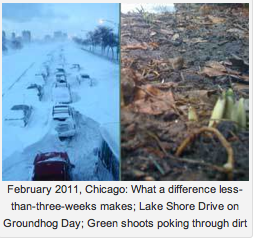We are flirting with 60 degrees. There are robins. The chill is gone from the wind. Our local groundhog, whose prediction came a day early this year—the zoo was closed on February 2—was right: early spring. Scratch that. Earliest spring.
Yes, it’s going to get cold again. Snow will fall. Water will freeze. But it won’t last. The earth is now tilted in our favor.
The first study focuses the intensity of rain storms and blizzards, analyzing a half century’s-worth of rain gauge data from 6,000 reporting stations run through a variety of climate models. Weirdly, the models taking into account GHGs tend to low-ball the effects compared to actual changes in precipitation tallies. It other words, it’s soggier in real life.
Notably, the research doesn’t include data after 1999, which is when a significant number of recording stations were shut down. Yet even when the “best science available” isn’t as good as it might have been, it appears, at least in this case, to have been good enough to raise some major concerns.
Still, one wonders whether the missing data could have helped predict this winter’s record snows in Korea, the string of Nor’easters in New England, or the recent megafloods in Germany and Pakistan. And if data from the Southern hemisphere had been included, would we have seen a pattern leading to the catastrophic storms in Australia and Sri Lanka?
FROM PATTERNS TO PREDICTIONS
The second study is, in a sense, much more ambitious: linking a specific weather event—floods in England 11 years ago—to man-mediated global warming. That kind of pin-point precision usually gets lost in climate study footnote caveats that point to variables surrounding any one particular storm.
…The researchers ran thousands of simulations of the weather in autumn 2000 (using idle time on computers made available by a network of volunteers) with and without the temperature rises caused by man-made global warming. They found that, in nine out of 10 cases, man-made greenhouse gases increased the risks of flooding. This is probably as solid a signal as simulations can produce, and it gives us a clear warning that more global heating is likely to cause more floods here…
…both models and observations also show changes in the distribution of rainfall, with moisture concentrating in some parts of the world and fleeing from others: climate change is likely to produce both more floods and more droughts.
(The Guardian)
1) These calculations were made possible by donations of otherwise idle computer time--40,000 years-worth all told. Even in an era of slashed research budgets, there are ways to make enough sense of available data to drive policy decisions (along with, potentially, lawsuits against power companies and insurance rate hikes).
2) We are all already paying the price—literally. Food costs are up by a nearly a third from a year ago, a spike so severe, the World Bank has voiced concern. According to its calculations, 44 million people tipped into poverty due to higher food costs since June, 2010. Other commodities such as cotton are also up dramatically. Manufacturers are reigning in earnings estimates, citing weather-related crop shortfalls. Retailers,including Wal-Mart, are also bracing for the fall-out. The only thing going up is demand as global population continues to increase.
3) Soaring food costs, along with soaring unemployment and decades of repression, are fueling protests across North Africa, with global geopolitical ramifications.
Although higher commodity prices should at least be good news for growers, national subsidies have distorted global markets. In Africa, for example, even farmers with high-demand crops such as cotton can find it difficult to eek out a living.
A WIN-WIN AMIDST THE LOSE-LOSE
All in all, pretty bleak stuff. Except for the one little ray of good news / bad news hope that if the shift in climate is indeed driven by fossil fuel emissions—as a growing mountain of evidence indicates—maybe we can still do something about it. It may be too late to get the climate train back on long-term track, but still possible to slow it down. That’s something.
Last fall, we wrote about some encouraging news on that front: an agreement between Greenpeace and the Consumer Goods Forum, which represents dozens large / multinational manufacturers, mandating a switch to climate-friendlier cooling technologies. The so-called “F-gases” released by traditional refrigerants account for a whopping “17% of the world’s global warming impact,” according to Greenpeace Solutions director Amy Larkin, who helped broker the deal. “That’s not annual emissions. That’s cumulative impact.”
Although several of the biggest companies, led by Coca-Cola, are already well on their way to making the switch, the language in the CGF agreement was softened at the last minute: Instead of requiring members to complete the transition by 2015, they are only required to begin making the transition by 2015.
What are they waiting for? Climate change-driven extreme weather is already taking a toll on bottom lines and shareholder confidence. F-gases may only a piece of the puzzle, but a piece that consumer goods companies can take the lead on: “positive change” that’s good for profits, too. In an era of a lot of lose-lose, that’s a rare win-win.
- “And Now for Some Rare Good News—Really” (TrackerNews editor’s blog)
- “Trees, Food, Pakistan & the Lessons of Medieval Monks: How Ecosystems Thinking Can (Still) Save the World” (TrackerNews editor’s blog)
- “Cry Me a River…and Pass Me a Shovel: On Rain, Snow, Sleet and Ice, Atmospheric Rivers and a World Gone Soggy” (TrackerNews editor’s blog)
- “Hot, Cold, Wet, Dry: When Weather Becomes Climate” (TrackerNews editor’s blog)










